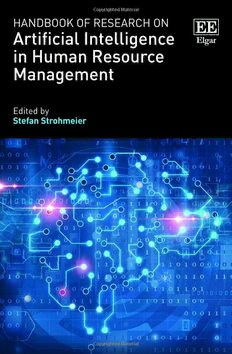Table Of ContentHANDBOOK OF RESEARCH ON ARTIFICIAL
INTELLIGENCE IN HUMAN RESOURCE MANAGEMENT
Handbook of Research on Artificial
Intelligence in Human Resource
Management
Edited by
Stefan Strohmeier
Professor of Management Information Systems, Chair of Management
Information Systems, Saarland University, Germany
Cheltenham, UK • Northampton, MA, USA
© Stefan Strohmeier 2022
All rights reserved. No part of this publication may be reproduced, stored in a retrieval system
or transmitted in any form or by any means, electronic, mechanical or photocopying, recording,
or otherwise without the prior permission of the publisher.
Published by
Edward Elgar Publishing Limited
The Lypiatts
15 Lansdown Road
Cheltenham
Glos GL50 2JA
UK
Edward Elgar Publishing, Inc.
William Pratt House
9 Dewey Court
Northampton
Massachusetts 01060
USA
A catalogue record for this book
is available from the British Library
Library of Congress Control Number: 2022931121
This book is available electronically in the
Business subject collection
http://dx.doi.org/10.4337/9781839107535
ISBN 978 1 83910 752 8 (cased)
ISBN 978 1 83910 753 5 (eBook)
EEP BoX
Contents
List of figures vii
List of tables ix
List of contributors x
Preface xii
1 Artificial intelligence in human resources – an introduction 1
Stefan Strohmeier
PART I APPLICATIONS OF ARTIFICIAL INTELLIGENCE IN
HUMAN RESOURCES
PART I.1 APPLICATIONS OF MACHINE LEARNING IN HUMAN RESOURCES
2 HR machine learning – an introduction 25
Stefan Strohmeier
3 HR machine learning on text data 46
Felix Gross
4 HR machine learning on audio and video data 68
Carmen Fernández-Martinez and Alberto Fernández
5 HR machine learning on social media data 89
Jake T. Harrison and Christopher J. Hartwell
6 HR machine learning in recruiting 105
Sven Laumer, Christian Maier, and Tim Weitzel
7 Machine learning in HR staffing 127
Florian J. Meier and Sven Laumer
8 Machine learning in personnel selection 149
Cornelius J. König and Markus Langer
PART I.2 FURTHER APPLICATIONS OF ARTIFICIAL
INTELLIGENCE IN HUMAN RESOURCES
9 HR knowledge representation and reasoning 169
Jorge Martinez-Gil
10 HR robotic process automation 187
Peter Fettke and Stefan Strohmeier
v
vi Handbook of research on artificial intelligence in human resource management
11 HR evolutionary computing 207
Lena Wolbeck and Charlotte Köhler
12 HR natural language processing – conceptual overview and state of the
art on conversational agents in human resources management 226
Sven Laumer and Stefan Morana
13 HR affective computing 243
William J. Becker, Sarah E. Tuskey, and Constant D. Beugré
PART II CONSEQUENCES OF ARTIFICIAL INTELLIGENCE IN
HUMAN RESOURCES
14 Consequences of artificial intelligence in human resource management 261
Maarten Renkema
PART III NORMATIVE ISSUES OF ARTIFICIAL INTELLIGENCE IN
HUMAN RESOURCES
15 Explainability of artificial intelligence in human resources 285
Markus Langer and Cornelius J. König
16 Fairness of artificial intelligence in human resources – held to a higher
standard? 303
Sandra L. Fisher and Garret N. Howardson
17 Accountability of artificial intelligence in human resources 323
Katharina A. Zweig and Franziska Raudonat
18 Legitimacy of artificial intelligence in human resources – the legal
framework for using artificial intelligence in human resource management 337
Kai von Lewinski and Raphael de Barros Fritz
PART IV RESEARCH ISSUES OF ARTIFICIAL INTELLIGENCE IN
HUMAN RESOURCES
19 Design considerations for conducting artificial intelligence research in
human resource management 353
Richard D. Johnson and Dianna L. Stone
20 Employing artificial intelligence in human resources research 371
Chulin Chen and Richard Landers
Index 392
Figures
1.1 Intertwining of conventional AI categories 6
1.2 Integrated categorization of AI 8
1.3 Current state of AI in HR 10
2.1 Process of HR machine learning 26
2.2 Algorithms of HR machine learning (modified from Piazza, 2010) 28
3.1 Preparation of text data 48
3.2 Tasks of machine learning on text data 51
4.1 Example of facial detection (outer gray lines) and facial feature
extraction (white lines and points) 75
4.2 Video interview analysis 80
6.1 Person–environment fit (Jansen & Kristof-Brown, 2006; Muchinsky &
Monahan, 1987) 107
6.2 The HR recruiting machine learning model 111
7.1 HR staffing model 129
7.2 HR staffing ML model 138
9.1 Description of a human resource management system making use of
techniques based on knowledge representation 177
9.2 Ontology of programming languages whereby two filters have been
applied to assess the degree of matching between Java and C# 179
11.1 Exemplary occurrence of staffing, scheduling, and rescheduling in
human resources in one year 208
11.2 Scheme of an evolutionary algorithm based on Eiben and Smith (2015b) 210
11.3 Cumulative number of publications in the last 20 years: (a) areas of
human resources and evolutionary computing; (b) application areas of
evolutionary computing in human resources 216
12.1 HRM services provided to applicants (HR2A), employees (HR2E), and
managers (HR2B) 228
vii
viii Handbook of research on artificial intelligence in human resource management
12.2 HR conversational agent model 236
15.1 The relation of XAI methods, understanding, and outcomes 293
16.1 Confusion matrix example 310
Tables
2.1 Data of HR machine learning 30
4.1 Use cases of ML in HR audio and video data 73
5.1 Categorization of social media platforms 91
6.1 Supervised learning machine learning algorithms (based on Rudolph, 2020) 109
6.2 Papers using machine learning approaches predicting person–
environment fit dimensions 112
6.3 Information extracted to be used in HR machine learning 116
7.1 Reviewed literature 134
8.1 Current status of the field 161
12.1 Descriptive results of the literature search phases 231
12.2 Literature review results 232
14.1 An organizing framework for the research on consequences of AI in HRM 263
16.1 Typical confusion matrix 310
17.1 Possible accountability relationships between different roles in the
socio-technical system using an ADM system to make decisions about people 328
17.2 HR process model and Long Chain of Responsibilities divided into three phases 329
17.3 Roles of actors in the HR context 331
19.1 Research designs of HRM studies with an AI focus 354
ix

